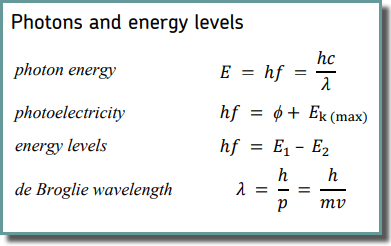Photoelectric Effect - Multiple Choice Questions Q1. The intensity of a monochromatic light source is increased. Which of the following is correct?
Choice C is the correct answer
Q2. A beam of light of wavelength λ is incident on a clean metal surface and photoelectrons are emitted. The wavelength of the light is halved but energy incident per second is kept the same. Which row in the table is correct?
The increase in energy given to each electron when the freeing occurs will result in excess KE of released photoelectrons. Choice C is the correct answer.
Q3. Photons of wavelength 290 nm are incident on a metal plate. The work function of the metal is 4.1 eV What is the maximum kinetic energy of the emitted electrons?
c = fλ f = c/λ hf = hc/λ = φ + Ek (MAX) Ek (MAX) = hc/λ - φ φ = 4.1 eV φ = 4.1 x 1.6 x 10-19 J φ = 6.56 x 10-19 J ∴ Ek(MAX) = 6.63 x 10-34 x 3.0 x 108/(290 x 10-9) - 6.56 x 10-19 Ek(MAX) = (6.86 - 6.56) x 10-19 Ek(MAX) = 0.3 x 10-19J Ek(MAX) = 0.3 x 10-19/1.6 x 10-19 eV Ek(MAX) = 0.19 eV Choice A Q4. When light of a certain frequency greater than the threshold frequency of a metal is directed at the metal, photoelectrons are emitted from the surface. The power of the light incident on the metal surface is doubled. Which row shows the effect on the maximum kinetic energy and the number of photoelectrons emitted per second?
Choice C Q5. Line X on the graphs below shows how the maximum kinetic energy of emitted photoelectrons varies with the frequency of incident radiation for a particular metal.
Which graph shows the results for a metal Y that has a higher work function than X?
|
Follow me...
|







